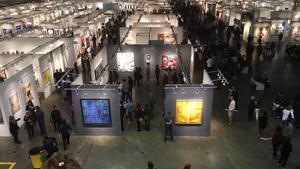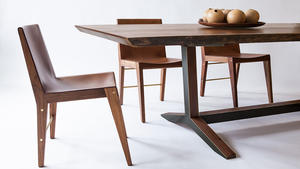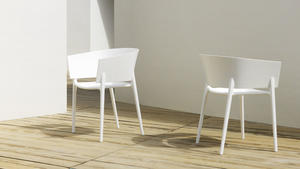A timber “forest” sprung up at London’s Victoria and Albert Museum earlier this month. Timber columns, designed by Turner Prize–nominated architecture firm Assemble, were designed to celebrate the centenary of the birth of renowned furniture maker Robin Day. Day was born in 1915, and his nearly seven-decade career included work such as 1963’s Polypropylene chair, which sold tens of millions throughout the world. Assemble’s exhibit is informed by Day’s childhood in High Wycombe, a British town known for beechwoods and timber-furniture factories. Exhibit curator Jane Withers shares her insight into both the exhibit and Day’s lasting contributions.
What is Day’s single greatest contribution to the design world?
Day’s greatest contribution to design is in utilitarian mass-produced seating: the Polypropylene chair, of course, but one might also extend that to his other seating, for example, for the London Underground. Day managed to achieve that rare combination of rigorous functionality, simplicity, and elegance, at a low cost.
How did Day’s upbringing in the area of High Wycombe inform his aesthetic?
This certainly informed his profound feeling for and understanding of wood. As a child, Day played in the woods, experimenting by making bows and arrows and catapults, and gaining a technical understanding of wood that informed his early designs. At the time, High Wycombe was the center of British furniture making, and he studied at High Wycombe Technical School, which had close ties to the industry. Day’s deep feeling for wood comes across in his designs—from the sculptural organic forms to the appreciation of its warmth and tactility and his use of a rich variety of different veneers. This connection to wood and woods is beautifully projected through Assemble’s installation.
What was the most surprising discovery you made while you were curating this exhibit?
This was certainly when Paula Day, Robin’s daughter, sent me a batch of photos of his handmade works in wood. It was a total surprise to find that this rigorous industrial designer retreated to his cottage at weekends and made these rustic but amazing pieces. At first, the contrast is surreal, but once you get over this, the common ground is more interesting—the directness and rigorous functionality, the feeling for wood, and enjoyment of sculptural form. The installation really makes an interesting conversation between his professional industrial design and the private works.
What is your favorite piece?
That’s difficult. In this exhibition, I think that Royal Festival Hall dining chair looks extraordinary mounted on a high plinth—delicate and powerfully sculptural at the same time. In terms of the handmade objects, I love the two walking sticks and their contrasting characters. Assemble’s installation really brings out the character of each piece.
Were there any challenges in curating this exhibit?
I think the biggest challenge was the initial one: how to conceive a small exhibit that could give a fresh insight into such a well-known designer for his centenary. I wanted to show his work in a fresh light but also give a more three-dimensional understanding of the man.




























